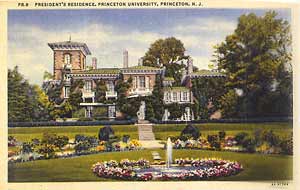
Page One
• White shares skill with words in new book and in the classroom
• Robertson Q&A available online
• Fun side of science draws local students
Inside
• Five seniors win Gates Cambridge Scholarships
• Designers chosen to give dining halls distinctive look
• Exhibition celebrates 100th anniversary of Lake Carnegie
People
• Griffin selected as University’s new registrar
• Denis Twitchett, historian of China, dies at age 80
• Spotlight
Almanac
• Nassau Notes
• Calendar of events
• By the numbers

By the numbers
Prospect House
Princeton NJ — Prospect House, the private dining club serving University faculty and staff, is one of the few University buildings not originally part of the campus.
• The building owes its name to the stone farmhouse first constructed on the site in the late-18th century by Col. George Morgan, western explorer, U.S. agent for Indian affairs and gentleman farmer. The superb eastern view from the farmhouse prompted Morgan to name his estate “Prospect.”

Historical postcard of Prospect House
• Prospect was acquired in 1824 by John Potter, a wealthy merchant from Charleston, S.C. He replaced the colonial structure with the present Italianate Victorian mansion designed by American architect John Notman in 1851-52.
• The College of New Jersey (as Princeton was then called) acquired the house and its 35-acre estate through a gift in 1878. The mansion then served for 90 years as the residence of six presidents of Princeton and their families. The first residents were James and Isabella McCosh, who had previously lived in Maclean House.
• Woodrow and Ellen Wilson and their three daughters moved into the house in 1902. Mrs. Wilson redesigned the garden and had a pool with a fountain placed at the center. To prevent students from taking shortcuts across the lawns and gardens, President Wilson had an iron fence erected in 1904.
• In 1968, President Robert Goheen and his family moved to the new president’s residence, Lowrie House. Prospect House was converted to a social and dining center for faculty and staff. With funds given by an anonymous donor, the glass addition that houses the Garden Room and Tap Room was created by architect Warren Plattner.
• Prospect House now provides a setting for dining, meetings and events. A list of special dining opportunities, including this month’s Russian Food Festival Buffet, Breakfast with the Easter Bunny and Easter Sunday Brunch, is available on the house’s Web site at www.princeton.edu/prospecthouse.
Sources: Prospect House Web site and “Prospect House at Princeton University” by William Selden.